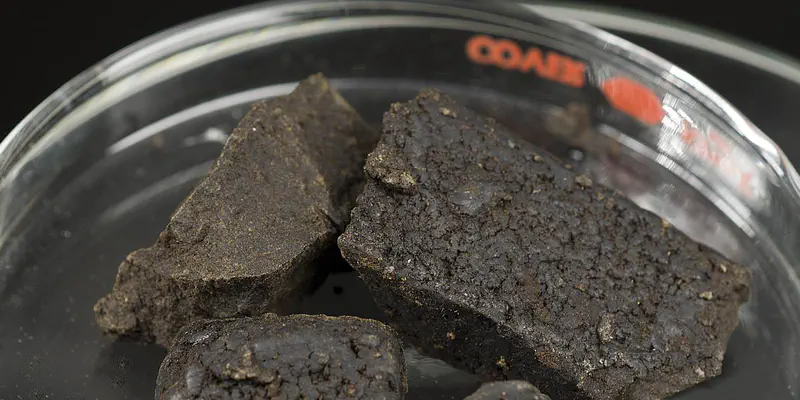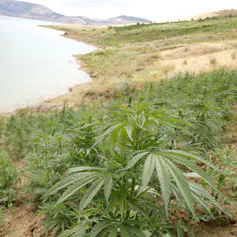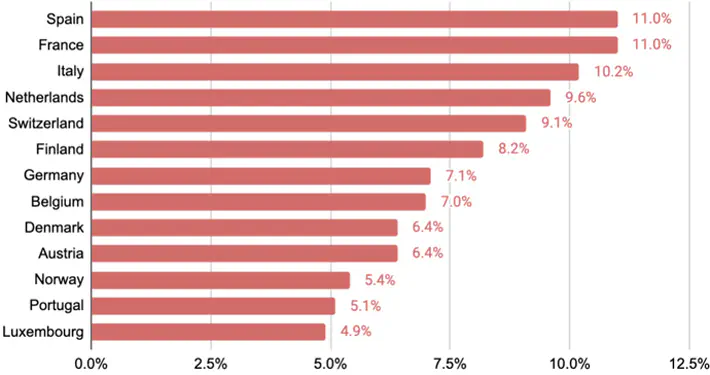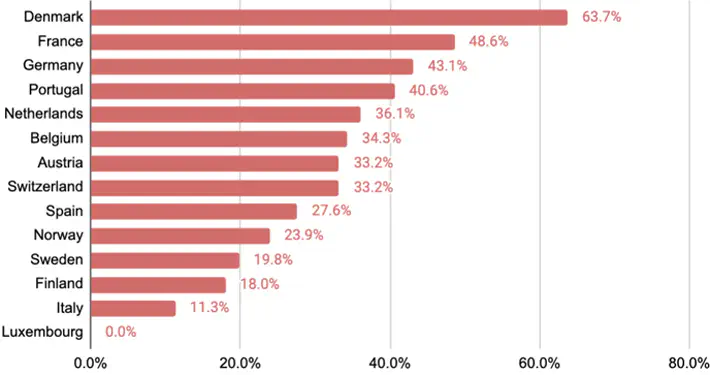DRUGS: WHAT YOU
NEED TO KNOW Booklet

Signs and Symptoms of Hashish Use

Courtesy of DEA.gov
Across Europe, cannabis is the most frequently used illicit drug.1 Historically, the most popular form of cannabis in use was hashish made from the concentrated resins of the plant. This has shifted since the arrival of the new millennium, and now herbal cannabis is number one. Cannabis resin is still the most popular drug in the southwest and northern parts of Europe. Even in those regions, it has yielded some popularity to the herbal form.
Hashish is formed by hand-rubbing or sifting the leaves of the plant to accumulate the resins. The resulting sticky product is then formed into bricks or balls. These bricks or balls are often adulterated with filler substances like soil, henna, wax, rosin, glue, flour, milk powder, coffee, used motor oil or animal excrement.2
Hashish may reach 40% potency of THC. Cannabis oil is also broadly available. It is made by extracting resins from the plant with solvents.3 The solvents are allowed to evaporate, leaving an oil that can potentially reach 70% or 80% THC potency. It’s more common that these oils will have a potency of 10% to 50% THC.3
Symptoms of Use
The symptoms of using hashish are the same as the symptoms of using herbal cannabis:
- Euphoria
- Drowsiness
- Increased heart rate
- Greater appetite
- Red eyes
- Higher blood pressure
- Dry mouth
- Talkativeness
According to a report from the European Monitoring Centre for Drugs and Drug Addiction (EMCDDA), there are several mental or functional symptoms of using this drug.
- Poor short-term memory
- Longer reaction time
- Poor motor coordination
- Impaired judgement
- Impairment of driving 4
- Poor dexterity 4
- Poor concentration and decision-making
- Increased risk of injury
Impaired judgement can have broad effects, especially if the intoxicated person engages in unprotected sex or tries to drive.
The short-term effects of cannabis use can last more than 24 hours, but the user may be unaware of the changes in their perceptions and abilities.
Effects of Higher Doses

High doses of cannabis can lead to severe effects like these:
- Anxiety
- Paranoia
- Panic attacks
- Lower life satisfaction
- Increased risk of developing psychosis
- Upper respiratory problems
- Delusions and hallucinations
- Mood swings
And, of course, heavy or long-term cannabis use can and does lead to addiction. Impairmentsof memory and cognition can become chronic.4 MRI scans even show changes in brain structure among long-term cannabis users.
The World Health Organization4 estimates the risk of addiction at 16% for those who begin using the drug in adolescence, and 33% to 50% among daily users.
Sources of Hashish
The primary countries supplying Europeans with hashish have shifted back and forth,5 sometimes as a result of conflicts within those countries. In the mid-1900s, Pakistan and Afghanistan were leading suppliers, with Lebanon entering the market later.

Morocco began to produce enough hashish to export in the late 1960s. For many years afterwards, Morocco was a global leader in hashish exports. Since the new millennium, there has been an increase in production of hashish within Europe, which has reduced Morocco’s share of the trade.
Despite these losses, Morocco still maintains a leadership position in the distribution of this product. Production is heavy in the Rif Mountains in the northern part of the country. Currently, the finished product is often trucked past Casablanca to Sidi Abed on the coast.6 From there it goes by boat to La Linea on the coast of Spain. This town of only 65,000 is thought to be the relay point for 80% of the hashish consumed in Europe.7 That would mean that 280,000 tonnes of hashish arrive every month to supply European appetites.
In 2017, Spanish police seized more than 145,000 kilos of hashish in the entirety of the country, an increase of 50% over 2016. In 2018, the number of kilos seized reached 167,000 kilos.8 France was in second place with 76,000 kilos seized. Denmark was in third place with 18,000 kilos seized. According to EMCDDA, Denmark is another major hub for the distribution of hashish.5
Use of Hashish
It is difficult to separate the statistics for herbal and resin cannabis use because not all countries make a distinction when calculating their use statistics.5
It’s estimated that 849 million Europeans between the ages of 15 and 64 have tried cannabis at least once. On average across all EU members, 13.3% of young adults (ages 15-34) have used the drug in the past year.
And how many are using cannabis in herbal or resin form daily or nearly daily? About three million people, or 1% of those aged 15 to 64.
Which Countries are the Heaviest Users?
According to the most recent statistics in each country, here’s how they compare:

Courtesy of statista.com
These numbers do not always relate to the proportion of people needing treatment in each country. The next chart shows how many people go to rehab for cannabis addiction out of all those seeking help.

Courtesy of statista.com
According to the World Health Organization (WHO), those seeking treatment for addiction to cannabis are younger than those seeking help for any other type of addiction, for example, opioids, cocaine or stimulants.
Outcomes of Cannabis Use
It is widely known that cannabis use is not associated with fatal overdoses. However, a study in the United States followed 45,000 people who had been hospitalized with a diagnosis of cannabis dependence or abuse. After 16 years of monitoring, this group had a death rate four times that of the general population. The reason for this increase was not understood.
A long-term study in New Zealand revealed what happened to groups of heavy users.4 These groups showed these outcomes:
- Lower income
- Lower college degree completion
- Greater need for economic assistance
- Higher unemployment
- Higher rates of use of other drugs
Other studies in Australia, New Zealand and the United States revealed that those who were regular users of cannabis were more likely to use heroin and cocaine and that the younger they were when they started consuming cannabis products, the more likely they were to use these other drugs.9
Sources:
-
Jonathan Schettino, et al.; (Delphi Institute, Berlin, Germany); Eva Hoch; (Department of Addiction Research and Addictive Behaviours, Central Institute of Mental Health, Mannheim, Germany); European Monitoring Centre for Drugs and Drug Addiction (2015), “Treatment of cannabis-related disorders in Europe” EMCDDA Publication (PDF) ↩︎
-
Pierre-Arnaud Chouvy, European Monitoring Centre for Drugs and Drug Addiction (2016), “The supply of hashish to Europe—Background paper commissioned by the EMCDDA for the 2016 EU Drug Markets Report” EMCDDA Publication (PDF) ↩︎
-
altomstoffer.dk, “HASH”. altomstoffer.dk Article ↩︎ ↩︎
-
World Health Organization (2016), “The health and social effects of nonmedical cannabis use”. WHO Publication (PDF) ↩︎ ↩︎ ↩︎ ↩︎ ↩︎
-
European Monitoring Centre for Drugs and Drug Addiction, “Changes in Europe’s cannabis resin market”. EMCDDA Article ↩︎ ↩︎ ↩︎
-
Ahmed Eljechtimi; Reuters.com (2020), “Moroccan smugglers embark on long new route to ship drugs to Europe”. Reuters News Article ↩︎
-
The Local ES—thelocal.es (2018), “80 per cent of European hashish smuggled in every year to Spanish town near Gibraltar”. The Local ES News Article ↩︎
-
Statista.com (2020), “Number of seizures of cannabis resin in the European Union in 2018, by country”. Statista.com Chart ↩︎
-
National Academies of Sciences, Engineering, and Medicine; Health and Medicine Division; Board on Population Health and Public Health Practice; Committee on the Health Effects of Marijuana: An Evidence Review and Research Agenda. Washington (DC): National Academies Press (US) via the National Center for Biotechnology Information (2017), “The Health Effects of Cannabis and Cannabinoids: The Current State of Evidence and Recommendations for Research”. NCBI Study ↩︎

 ®
®
